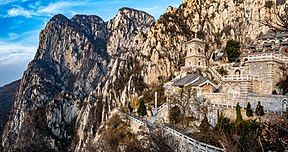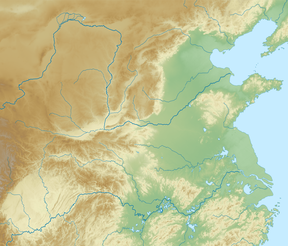
Back جبل مونت سونج ARZ Mont Song Catalan Song Shan (bukid) CEB Sung-šan Czech Song Shan Danish Song Shan German Monte Song Spanish Songshan Basque کوه سونگ Persian Mont Song French
| Mount Song | |||||||||||||||||||||||
|---|---|---|---|---|---|---|---|---|---|---|---|---|---|---|---|---|---|---|---|---|---|---|---|
 The Songshan Buddhist Academy, a modern monastery perched for effect on Lian Tian Feng. | |||||||||||||||||||||||
| Highest point | |||||||||||||||||||||||
| Peak | Lian Tian Feng | ||||||||||||||||||||||
| Elevation | 1,512 m (4,961 ft)[1] | ||||||||||||||||||||||
| Prominence | 1,221 m (4,006 ft)[2] | ||||||||||||||||||||||
| Parent peak | Mount Everest | ||||||||||||||||||||||
| Isolation | 82.3 km (51.1 mi) SW | ||||||||||||||||||||||
| Coordinates | 34°28′21″N 112°56′05″E / 34.472416°N 112.934647°E | ||||||||||||||||||||||
| Dimensions | |||||||||||||||||||||||
| Length | 100 km (62 mi) E-W[3] | ||||||||||||||||||||||
| Width | 60 km (37 mi) N-S[3] | ||||||||||||||||||||||
| Area | 450 km2 (170 sq mi)[4] | ||||||||||||||||||||||
| Naming | |||||||||||||||||||||||
| English translation | "Lofty Mountain". | ||||||||||||||||||||||
| Language of name | |||||||||||||||||||||||
| Chinese name | |||||||||||||||||||||||
| Chinese | 嵩山 | ||||||||||||||||||||||
| |||||||||||||||||||||||
| Geography | |||||||||||||||||||||||
Location in North China Plain | |||||||||||||||||||||||
| Country | China | ||||||||||||||||||||||
| Province | Henan | ||||||||||||||||||||||
| Climbing | |||||||||||||||||||||||
| Easiest route | Cable car | ||||||||||||||||||||||
| Official name | Historic Monuments of Dengfeng in "The Centre of Heaven and Earth" | ||||||||||||||||||||||
| Criteria | Cultural: iii, vi | ||||||||||||||||||||||
| Reference | 1305 | ||||||||||||||||||||||
| Inscription | 2010 (34th Session) | ||||||||||||||||||||||
| Website | www.worldheritagesite.org/list/Dengfeng | ||||||||||||||||||||||
Mount Song (Chinese: 嵩山; pinyin: Sōngshān, "lofty[5] mountain") is an isolated mountain range in north central China's Henan Province, along the southern bank of the Yellow River. It is known in literary and folk tradition as the central mountain of the Five Great Mountains of China.[6] Since at least as early as the early 1st millennium BC, Chinese astronomical mythology had acquired the idea that Mount Song is "the centre of Heaven and Earth." It was respected as such by the successive dynasties of the Chinese Empire.[7]
The name Songshan also applies to a peak of the range located at 34°30′38″N 112°56′05″E / 34.510627°N 112.934647°E, elevation 1,492 m (4,895 ft). It is the 4th highest peak, but second in prominence at 869 m (2,851 ft).[8] Songshan National Scenic Spot is named after it. The highest peak in the range is Lian Tian Feng at 1,512 metres (4,961 ft), also most prominent at 1,221 m (4,006 ft). It is located at the coordinates shown for the article. On its upper slopes is the Sanhuangzhai Scenic Spot, further west seen from Route G1516 (Yanluo Expressway), which skirts the range on the south. The location is across the Shaoyang valley on the west side of which is Shaolin Monastery. The valley is well populated, in contrast to the forested and precipitous mountains.
The literature associated with this monastery, or "temple" (si) relates two folk-names of the range still in popular use due to their legendary status: Shaoshi Mountain, meaning all peaks west of the valley, and Taishi Mountain, all peaks east of the valley.[9] Mount Song thus appears to be a two-peak range when actually there are as many as the counter cares to count. The possible number depends on the counter's minimum allowed prominence.[i] PeakVisor, which records reported peaks in a given area, has recorded 44 for Denfeng, the lowest elevation being 959 m (3,146 ft).[8]
The Internet reports widely that Mount Song comprises 72 peaks, sometimes rounded off to 70. This is a mystical figure taken from the cosmology of the Chan Buddhists. In their ancient myth, Shaoshi and Taishi each have 36 peaks, one set of Yin and one set of Yang, which cancel each other out at the monastery, achieving a zero sum (of what remains speculative).[10] The numbers are not based on counting.
- ^ "Topographic map of Mount Song". opentopomap.org. Retrieved 2023-04-16.
- ^ "Lián Tiān Fēng". PeakVisor. Retrieved 21 October 2022.
- ^ a b Cite error: The named reference
lenwidwas invoked but never defined (see the help page). - ^ Cite error: The named reference
areawas invoked but never defined (see the help page). - ^ Ministry of Education Mandarin Chinese Dictionary (Revised), "Entry 嵩"
- ^ Goossaert 2008, p. 217 "It has been considered as the Central of the Five Peaks (*wuyue) since the late Zhou period."
- ^ ICOMOS 2008, pp. 14–15
- ^ a b "Dengfeng City". PeakVisor. Retrieved 20 October 2022.
- ^ Goossaert 2008, p. 917 "It is ranked as one of the Grotto-Heavens (*dongtian) and is usually divided between the Taishi 太 室 and Shaoshi 少室 ranges."
- ^ Shi, Yan Ming (2006). The Shaolin Workout. Holtzbrinck Publishers. p. 116.
Cite error: There are <ref group=lower-roman> tags or {{efn-lr}} templates on this page, but the references will not show without a {{reflist|group=lower-roman}} template or {{notelist-lr}} template (see the help page).
© MMXXIII Rich X Search. We shall prevail. All rights reserved. Rich X Search
